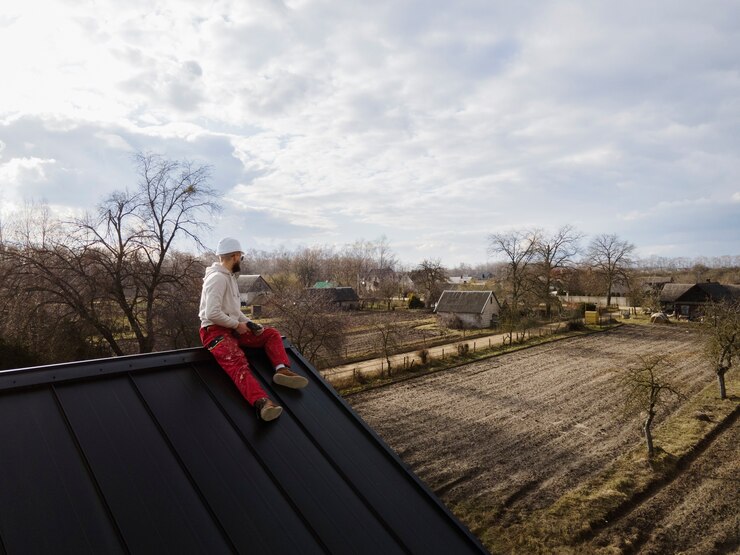Your home’s siding is more than just a decorative exterior; it’s a crucial barrier that protects your house from the elements. Over time, weather conditions can significantly impact the integrity and appearance of your siding. This is especially true in places like Calgary, where extreme weather is common. Understanding how different types of weather affect your house siding in Calgary and knowing how to address these issues can help you maintain your home’s curb appeal, energy efficiency, and structural integrity. In this blog, we’ll explore how various weather conditions impact your home’s siding and provide practical tips on how to protect and repair it.
1. Sun and Heat
Impact on Siding:
Sun and heat are often underestimated when considering weather-related damage to siding. Prolonged exposure to the sun’s ultraviolet (UV) rays can cause significant wear and tear on your siding, especially if it’s made of vinyl, wood, or fiber cement. UV rays can fade the color of your siding, making it look aged and dull. In addition, high temperatures can cause vinyl siding to warp, buckle, or become brittle. Wood siding is also vulnerable, as excessive heat can dry it out, leading to cracking and splitting.
What You Can Do:
- Regular Inspections: Regularly inspect your siding for signs of fading, warping, or cracking, especially during and after the summer months.
- UV-Resistant Coatings: Consider applying UV-resistant coatings or paints to your siding to minimize sun damage. This is particularly effective for wood and fiber cement siding.
- Shade Trees: Planting shade trees around your home can help block some of the sun’s harmful rays, protecting your siding and keeping your home cooler.
2. Rain and Humidity
Impact on Siding:
Rain and humidity are major concerns for homeowners, especially in regions that experience frequent or heavy rainfall. Water is one of the most damaging elements to siding, particularly wood and fiber cement. When water penetrates the siding, it can lead to rot, mold, and mildew growth. Over time, this moisture can cause the siding to deteriorate, compromising the structural integrity of your home. Vinyl siding, while more resistant to water, can still experience issues if water becomes trapped behind it, leading to mold growth and other problems.
What You Can Do:
- Proper Installation: Ensure your siding is properly installed with the appropriate barriers and sealants to prevent water infiltration.
- Regular Cleaning: Clean your siding regularly to remove dirt, mold, and mildew. For wood siding, this may involve power washing and applying a protective sealant.
- Gutters and Downspouts: Keep your gutters and downspouts clear of debris to ensure water is directed away from your siding. Consider installing splash blocks or extensions to further protect your foundation and siding.
- Caulking and Sealing: Regularly check and reapply caulking around windows, doors, and other openings to prevent water from seeping behind the siding.
3. Snow and Ice
Impact on Siding:
In colder climates, snow and ice pose significant challenges for homeowners. The weight of snow can put pressure on your siding, especially if it accumulates on your roof and then slides down onto the siding. Ice dams, which form when snow melts and refreezes, can cause water to back up under the siding, leading to water damage and mold growth. Additionally, the freeze-thaw cycle can cause siding materials, particularly wood and vinyl, to expand and contract, leading to cracks and other forms of damage.
What You Can Do:
- Snow Removal: Safely remove excess snow from your roof to prevent it from sliding down and damaging your siding. Use a roof rake to clear snow from the edges of your roof.
- Ice Dam Prevention: Insulate your attic and ensure proper ventilation to prevent the formation of ice dams. You can also install heating cables along the edge of your roof to melt ice and prevent buildup.
- Inspect After Winter: Once the snow and ice have melted, inspect your siding for any signs of damage, such as cracks, warping, or water stains, and address any issues immediately.
4. Wind and Storms
Impact on Siding:
High winds and storms can be particularly destructive to siding. Wind can lift and tear off siding panels, especially if they are not securely fastened. Flying debris during a storm can cause dents, cracks, or holes in the siding, compromising its protective barrier. In areas prone to hurricanes or tornadoes, wind damage can be even more severe, potentially leading to significant structural damage to your home.
What You Can Do:
- Secure Loose Panels: Regularly check your siding for loose panels and secure them to prevent wind from tearing them off during a storm.
- Storm-Resistant Siding: Consider investing in storm-resistant siding materials, such as fiber cement, which is more durable and less prone to wind damage.
- Protective Measures: Trim trees and shrubs around your home to minimize the risk of branches or debris hitting your siding during a storm. If a severe storm is forecasted, consider securing your windows and doors with storm shutters to protect your siding from flying debris.
5. Extreme Cold
Impact on Siding:
Extreme cold can cause significant stress on siding materials, particularly wood and vinyl. When temperatures drop, these materials can become brittle and more susceptible to cracking and splitting. For wood siding, extreme cold can also cause the material to contract, leading to gaps and openings where cold air and moisture can seep in. Additionally, if there is moisture present behind the siding, it can freeze and expand, causing further damage.
What You Can Do:
- Insulate Your Home: Proper insulation in your home can help reduce the impact of extreme cold on your siding by maintaining a more consistent temperature inside and outside your home.
- Repair Gaps: Inspect your siding for any gaps or cracks before the onset of winter and repair them to prevent cold air and moisture from penetrating your home’s exterior.
- Paint and Seal: Apply a fresh coat of paint or sealant to wood siding before winter to protect it from the elements and reduce the risk of cracking.
6. Hail
Impact on Siding:
Hailstorms can be incredibly damaging to siding, especially vinyl and aluminum. Hailstones can dent, crack, or puncture siding, leaving your home vulnerable to further damage from rain and wind. Even small hailstones can cause noticeable damage, reducing your home’s curb appeal and potentially leading to costly repairs.
What You Can Do:
- Impact-Resistant Siding: Consider upgrading to impact-resistant siding materials, such as fiber cement or engineered wood, which are better equipped to withstand hail damage.
- Inspect After Storms: After a hailstorm, thoroughly inspect your siding for damage. Even minor dents or cracks should be addressed promptly to prevent further deterioration.
- Insurance Coverage: Review your homeowner’s insurance policy to ensure you have adequate coverage for hail damage. If you live in an area prone to hailstorms, it’s worth considering additional coverage options.
Conclusion
Weather can have a profound impact on your home’s siding, affecting its appearance, durability, and protective capabilities. From sun and heat to rain, snow, wind, and hail, each type of weather presents unique challenges that require specific preventive measures and timely repairs. By understanding how weather affects your siding and taking proactive steps to maintain and protect it, you can extend the life of your home’s exterior and ensure it continues to provide a safe and attractive environment for years to come.
Regular inspections, proper maintenance, and the use of weather-resistant materials are key strategies in safeguarding your home’s siding against the elements. Whether you’re dealing with the scorching sun, heavy rain, or harsh winter conditions, taking the time to care for your siding will pay off in the long run, preserving both your home’s value and its visual appeal.





